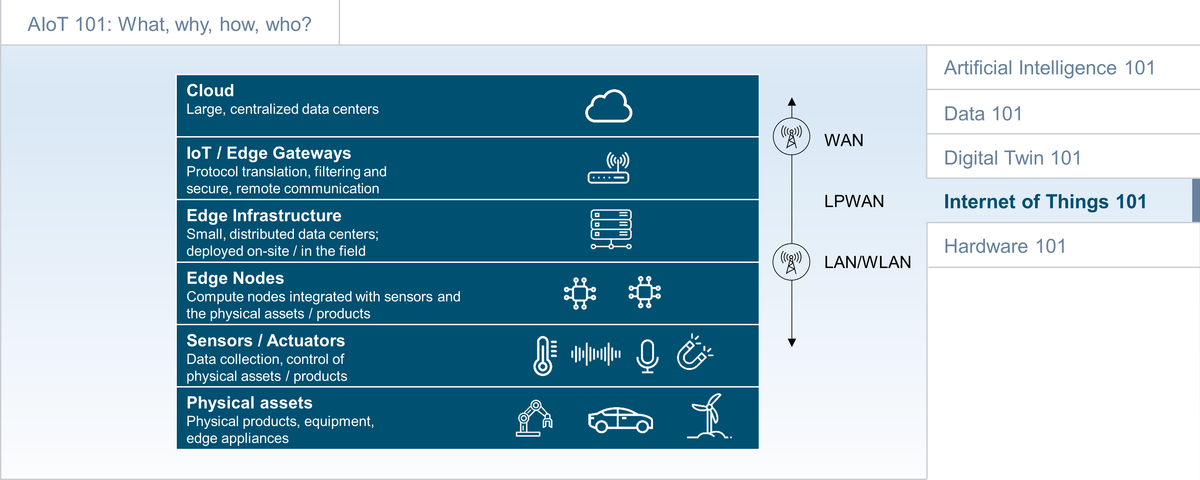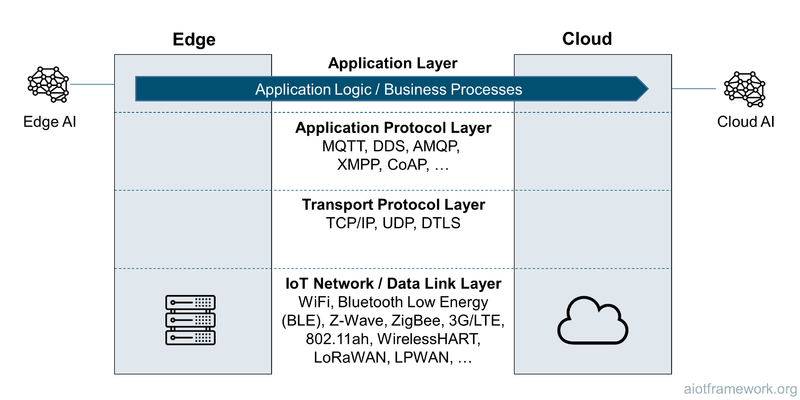Internet of Things 101: Difference between revisions
| Line 48: | Line 48: | ||
=== IoT Protocol Layers === | === IoT Protocol Layers === | ||
Connectivity between the IoT edge nodes and the backend requires different protocol layers. Similiar to the postal services with letters and parcels, these protocol layers are responsible for packaging, addressing and routing data in various forms. | |||
At the top layers, application-specific protocols are responsible for supporing information exchange on the business level. | |||
Lower-level transport protocol layers are responsible for the transfer of anonymous data packages (business level data is often split into smaller packages for transportation purposed, and then re-assembed on the receiver side). The most well-known such protocol is TCP/IP, which is the standard protocol in the Internet. | |||
IoT communication networks must establish a physical data link between the different nodes involved. This is happening using a variety of standardized and proprietary protocols, especially for wireless communication. | |||
[[File:0.3.1 IoT Stack.png|800px|frameless|center|IoT Protocol Layers]] | [[File:0.3.1 IoT Stack.png|800px|frameless|center|IoT Protocol Layers]] | ||
=== IoT Connectivity === | === IoT Connectivity === | ||
[[File:2.2-iv-NetworkArchitecture.png|800px|frameless|center|AIoT Network Architecture]] | [[File:2.2-iv-NetworkArchitecture.png|800px|frameless|center|AIoT Network Architecture]] | ||
Revision as of 21:54, 5 June 2021

This section provides an Internet of Things 101, including a brief overview, a discussion of IoT Sensors and Actuators, IoT Architecture,IoT Protocol Layers, and IoT Connectivity.
Internet of Things
The Internet of Things (IoT) describes the concept of connecting physical objects (a.k.a. the "Things") which are embedded with sensors and actuators over the Internet. This connection can either be directly between physical objects, or between physical objects and a back-end data center (cloud or on-premise). Surprisingly often, this connectivity will make use of Internet protocols (IP, UDP, etc.), but not communicate via the Internet but rather via closed enterprise networks. IoT has emerged as a concept following earlier approaches like m2m (Machine-to-Machine communication) and Telematics, usually adding a richer set of digital services. Industrial Internet of Things (IIoT) refers to industrial IoT applications. Edge computing is quickly emerging as the field-based compute capacity closer to the physical objects, and as a counterpart to centralized cloud-computing. The boundaries between Edge computing, IoT, and embedded computing can sometimes be blurry. The term IoT Edge Node is usually used to refer to compute nodes which are embedded with physical object in the field. Other types of edge equipment can be independent of physical assets, e.g. local data centers.
IoT Architecture
An IoT architecture must create a bridge between physical assets in the field and a cloud or on-premise backend.
This first challenge is the integration of the actual physical asset (or product, appliance, equipment, etc.). This can usually be done as part of a line-fit process during manufacturing, or as a retrofit process (especailly for legacy assets). Asset integration has to deal with issues such as power supply, ruggedization, antenna positioning, etc.
On - or close to - the asset, the IoT architecture is usually positioning an edge layer. The first element here are sensors or actuators (some might argue that this is part of the asset, not part of the edge - which can also be a valid design). In addition, we often find edge applications (e.g. pre-processing of sensor data) and edge AI / Asset Intelligence (e.g. sensor data fusion and autonomous control). Modern edge platform provide a runtime for local compute resources, as well as a gateway functionality for remote communication.
In the backend, AIoT backend applications and backend AI / swarm intelligence operate on the data received from the assets in the field. This is often suport by IoT/IIoT-specific middleware, provided as Platform-as-a-Service (PaaS). Normal Cloud-PaaS services as well as Infrasructure-as-a-Service (IaaS) are reqiured as the foundation.
Not to be underestimated is the need to integrate with existing Enterprise Applications. Most IoT projects also have an EAI element (Enterprise Application Integration).
IoT Sensors and Actuators
Most IoT system benefit from the use of sensors and actuators to acquire data from the field, and control the behavior of the assets in the field. Typical sensor categories include image & video, acoustic & noise, temperature, moisture, light, presence & proximity, motion, gyroscope (rotation & velocity), water level and chemicals. Typical actuators include motors (servo, stepper, DC), linear actuators, relays (electric switch) and solenoids (electromagnets).
IoT Protocol Layers
Connectivity between the IoT edge nodes and the backend requires different protocol layers. Similiar to the postal services with letters and parcels, these protocol layers are responsible for packaging, addressing and routing data in various forms.
At the top layers, application-specific protocols are responsible for supporing information exchange on the business level.
Lower-level transport protocol layers are responsible for the transfer of anonymous data packages (business level data is often split into smaller packages for transportation purposed, and then re-assembed on the receiver side). The most well-known such protocol is TCP/IP, which is the standard protocol in the Internet.
IoT communication networks must establish a physical data link between the different nodes involved. This is happening using a variety of standardized and proprietary protocols, especially for wireless communication.



